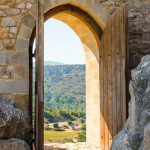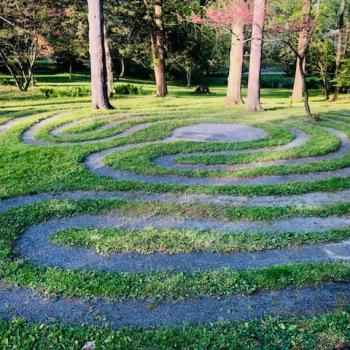A lump of clay thrown on the potter’s wheel became a vessel. Lester Morris, tech consultant by day, recognizes his time at the wheel as his spiritual practice. He invited Alignment into his basement studio virtually for a session of contemplative practice. The pots and bowls that Lester shaped during our time together became vessels for far more than anyone anticipated.
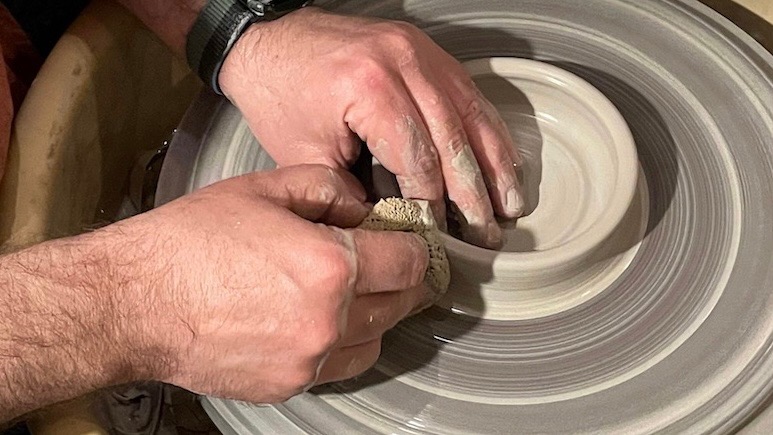
One of the main intentions of Alignment: Interfaith Contemplative Practices is the recognition of the sacred in the ordinary. We look for the presence of the divine in the workings of our life that both center us and move us forward. That connect us to the divinity that exists at the depths of our existence. And the divinity that challenges us to step beyond our own circumstances. To connect with those who are different from us but also deeply a part of our human experience. We find our practices of prayer in the routines and rituals that are already a part of daily life. The ordinary, set apart in the very recognition of it, becomes the sacred. And so it is with Lester’s wheel spinning in meditative practice that yields a vessel. A symbol of our shaping, our abundance, and our voids.
The Clay and the Hands That Shape It
There is nothing much more common than a pot. A bowl. That which holds our sustenance. Which fills our tables and our cupboards. From which we bathe. And into which we pour that which no longer serves. Dredged up from the sea after 2500 years, a pot that carried oil or grain or wine from Roman transport speaks across the millennia – the earth made into vessel is part of the universal human experience. But when we step back to the view of the creation of the pot, that is when the divine enters. The hands of the potter become the hands of the creator, and we, the clay that is shaped by our encounter.
The Hebrew scriptures are replete with references to the potter and the clay, to pots and vessels. None more obvious perhaps than the words of the prophet Isaiah. But now, O Lord, you are our father, we are the clay, and you our potter, and we all are the work of your hand (Isa 64:8).
The prophet’s role is to be the voice of God for the people and the voice of the people for God.
The voice enabling divinity and humanity to be in relationship. Perhaps this reminds us that we are potters too. In recognizing the divine act of creation in the shaping of the pot on the wheel, we are reminded of the divinity that abides at the core of our being.
The Prophets Speak of Clay
The prophet Jeremiah who cries out at the time of the destruction of Jerusalem by the Babylonians speaks to the presence of the divine in the depths of human experience. We are assured that new life is not only a possibility but is the expectation when we place ourselves in the presence of the divine. Then I went down to the potter’s house, and there he was, making something on the wheel. But the vessel that he was making of clay was spoiled in the hand of the potter; so he remade it into another vessel, as it pleased the potter to make (Jer 18:3-4).
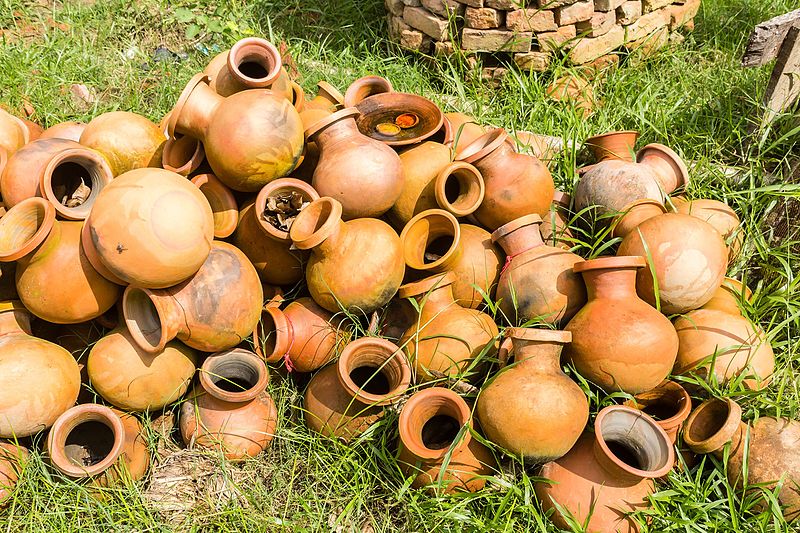
In the Islamic tradition of Jesus as prophet, Allah breathes into the clay form of a bird that Isa makes. The healing potential of the prophet comes from the will and permission of the one who makes the clay a living form. A symbol of that which came from the earth and which will fly to the outreaches of creation. Through the breath of the divine and the hands of the prophet potter, new life is given. From the Qur’an: Allah will say, when you designed from clay [what was] like the form of a bird with my permission, then you breathed into it and it became a bird with my permission (Surah Al-Ma’idah – 110)
إِذْ قَالَ ٱللَّهُ يَـٰعِيسَى ٱبْنَ مَرْيَمَ ٱذْكُرْ نِعْمَتِى عَلَيْكَ وَعَلَىٰ وَٰلِدَتِكَ إِذْ أَيَّدتُّكَ بِرُوحِ ٱلْقُدُسِ تُكَلِّمُ ٱلنَّاسَ فِى ٱلْمَهْدِ وَكَهْلًۭا ۖ وَإِذْ عَلَّمْتُكَ ٱلْكِتَـٰبَ
وَٱلْحِكْمَةَ وَٱلتَّوْرَىٰةَ وَٱلْإِنجِيلَ ۖ وَإِذْ تَخْلُقُ مِنَ ٱلطِّينِ كَهَيْـَٔةِ ٱلطَّيْرِ بِإِذْنِى فَتَنفُخُ فِيهَا فَتَكُونُ طَيْرًۢا بِإِذْنِى ۖ وَتُبْرِئُ ٱلْأَكْمَهَ وَٱلْأَبْرَصَ بِإِذْنِى ۖ وَإِذْ تُخْرِجُ ٱلْمَوْتَىٰ بِإِذْنِى ۖ وَإِذْ كَفَفْتُ بَنِىٓ إِسْرَٰٓءِيلَ عَنكَ إِذْ جِئْتَهُم بِٱلْبَيِّنَـٰتِ فَقَالَ ٱلَّذِينَ كَفَرُوا۟ مِنْهُمْ إِنْ هَـٰذَآ إِلَّا سِحْرٌۭ مُّبِينٌۭ ١١“
— Saheeh International
Clay as the Connector
Not only the earthen material of the pot but the function of the pot are foundationally common to our daily lives. In sacred ritual, we often see the ordinary clay pot as the point at which the divine comes into relationship with us. Madhvi Subrahmanian presenting at the International Academy of Ceramics writes of the Hindu use of earthen pots in ceremony. “The pot plays an important role in rituals where Gods and Goddess [sg] are projected to descend into the ghata or the pot during a ritual, which then becomes the intermediary between the devotee and the deity.” It symbolizes both abundance and the void. The overflowing pot symbolizes fertility and the empty pot represents the vastness of the cosmos.
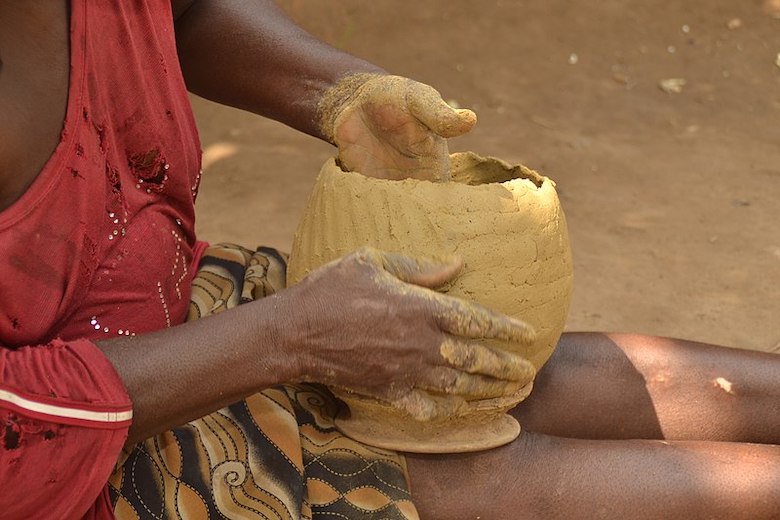
Adam Posner studies the sacred rituals of African-Pan-American religious systems through the lens of his work with clay. Through his fascinating work To Serve the Divine, he discusses the use of ordinary clay pots, cooking vessels for instance, that become a part of sacred ritual. He says that often the way they are adorned or filled or decorated leads to the view that the ordinary has become sacred. That the pots themselves are being worshiped. But he makes clear that the widespread practice among African and African-Caribbean traditions is that the pots are “temporary seats or housing for the divine essence; in other words the pot is not itself sacred, but rather it contains the spiritual force.”
Reflections on the Practice
As Lester Morris threw mounds of unshaped clay on his wheel, participants in Alignment’s session, Creative Clay, spent the half hour in meditative reflection. They engaged in their own spiritual practice as they sat in witness to Lester’s. And this practice was a shared one. The chat filled with messages of wonder, transformation, nourishment, and hope. The significance of the gentle touch to the clay that produces ripples of change allowed some to remember the ways in which their connection to the divine can be imperceivable. The pattern of energy and then the pause. One participant noted:
I’m remembering all the times when I have felt like a simple lump of clay, times when I may lack confidence or think I’m nothing special…and there have been so many other times that I’ve allowed myself to be formed and opened, lovingly cared for and molded. Also remembering how many people in my life have been a vessel, a container for me.
Lester’s vessels had become a vessel for our contemplative practice. The ordinary became the sacred. The practice of creating the common vessel becomes the vehicle for creating the space into which the divine enters.







